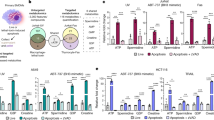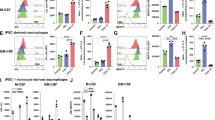Abstract
Macrophages rapidly engulf apoptotic cells to limit the release of noxious cellular contents and to restrict autoimmune responses against self antigens. Although factors participating in recognition and engulfment of apoptotic cells have been identified, the transcriptional basis for the sensing and the silent disposal of apoptotic cells is unknown. Here we show that peroxisome proliferator–activated receptor-δ (PPAR-δ) is induced when macrophages engulf apoptotic cells and functions as a transcriptional sensor of dying cells. Genetic deletion of PPAR-δ decreases expression of opsonins such as complement component-1qb (C1qb), resulting in impairment of apoptotic cell clearance and reduction in anti-inflammatory cytokine production. This increases autoantibody production and predisposes global and macrophage-specific Ppard−/− mice to autoimmune kidney disease, a phenotype resembling the human disease systemic lupus erythematosus. Thus, PPAR-δ has a pivotal role in orchestrating the timely disposal of apoptotic cells by macrophages, ensuring that tolerance to self is maintained.
This is a preview of subscription content, access via your institution
Access options
Subscribe to this journal
Receive 12 print issues and online access
$209.00 per year
only $17.42 per issue
Buy this article
- Purchase on Springer Link
- Instant access to full article PDF
Prices may be subject to local taxes which are calculated during checkout






Similar content being viewed by others
Accession codes
References
Savill, J. & Fadok, V. Corpse clearance defines the meaning of cell death. Nature 407, 784–788 (2000).
Henson, P.M., Bratton, D.L. & Fadok, V.A. The phosphatidylserine receptor: a crucial molecular switch? Nat. Rev. Mol. Cell Biol. 2, 627–633 (2001).
Savill, J., Dransfield, I., Gregory, C. & Haslett, C. A blast from the past: clearance of apoptotic cells regulates immune responses. Nat. Rev. Immunol. 2, 965–975 (2002).
Lauber, K., Blumenthal, S.G., Waibel, M. & Wesselborg, S. Clearance of apoptotic cells: getting rid of the corpses. Mol. Cell 14, 277–287 (2004).
Erwig, L.P. & Henson, P.M. Clearance of apoptotic cells by phagocytes. Cell Death Differ. 15, 243–250 (2008).
Ravichandran, K.S. & Lorenz, U. Engulfment of apoptotic cells: signals for a good meal. Nat. Rev. Immunol. 7, 964–974 (2007).
Miyanishi, M. et al. Identification of Tim4 as a phosphatidylserine receptor. Nature 450, 435–439 (2007).
Botto, M. et al. Homozygous C1q deficiency causes glomerulonephritis associated with multiple apoptotic bodies. Nat. Genet. 19, 56–59 (1998).
Scott, R.S. et al. Phagocytosis and clearance of apoptotic cells is mediated by MER. Nature 411, 207–211 (2001).
Cohen, P.L. et al. Delayed apoptotic cell clearance and lupus-like autoimmunity in mice lacking the c-mer membrane tyrosine kinase. J. Exp. Med. 196, 135–140 (2002).
Hanayama, R. et al. Autoimmune disease and impaired uptake of apoptotic cells in MFG-E8-deficient mice. Science 304, 1147–1150 (2004).
Chawla, A., Repa, J.J., Evans, R.M. & Mangelsdorf, D.J. Nuclear receptors and lipid physiology: opening the X-files. Science 294, 1866–1870 (2001).
Evans, R.M., Barish, G.D. & Wang, Y.-X. PPARs and the complex journey to obesity. Nat. Med. 10, 355–361 (2004).
Odegaard, J.I. et al. Macrophage-specific PPARγ controls alternative activation and improves insulin resistance. Nature 447, 1116–1120 (2007).
Odegaard, J.I. et al. Alternative M2 activation of Kupffer cells by PPARδ ameliorates obesity-induced insulin resistance. Cell Metab. 7, 496–507 (2008).
Kang, K. et al. Adipocyte-derived TH2 cytokines and myeloid PPARδ regulate macrophage polarization and insulin sensitivity. Cell Metab. 7, 485–495 (2008).
Blander, J.M. & Medzhitov, R. Regulation of phagosome maturation by signals from Toll-like receptors. Science 304, 1014–1018 (2004).
Hess, K.L., Babcock, G.F., Askew, D.S. & Cook-Mills, J.M. A novel flow cytometric method for quantifying phagocytosis of apoptotic cells. Cytometry 27, 145–152 (1997).
Desvergne, B., Michalik, L. & Wahli, W. Transcriptional regulation of metabolism. Physiol. Rev. 86, 465–514 (2006).
Barish, G.D., Narkar, V.A. & Evans, R.M. PPARδ: a dagger in the heart of the metabolic syndrome. J. Clin. Invest. 116, 590–597 (2006).
Sznaidman, M.L. et al. Novel selective small molecule agonists for peroxisome proliferator-activated receptor δ (PPARδ)—synthesis and biological activity. Bioorg. Med. Chem. Lett. 13, 1517–1521 (2003).
Slingsby, J.H. et al. Homozygous hereditary C1q deficiency and systemic lupus erythematosus. A new family and the molecular basis of C1q deficiency in three families. Arthritis Rheum. 39, 663–670 (1996).
Armbrust, T., Nordmann, B., Kreissig, M. & Ramadori, G. C1Q synthesis by tissue mononuclear phagocytes from normal and from damaged rat liver: up-regulation by dexamethasone, down-regulation by interferon γ and lipopolysaccharide. Hepatology 26, 98–106 (1997).
Breitkopf, K. et al. Thrombospondin 1 acts as a strong promoter of transforming growth factor β effects via two distinct mechanisms in hepatic stellate cells. Gut 54, 673–681 (2005).
Petry, F., Botto, M., Holtappels, R., Walport, M.J. & Loos, M. Reconstitution of the complement function in C1q-deficient (C1qa−/−) mice with wild-type bone marrow cells. J. Immunol. 167, 4033–4037 (2001).
Voll, R.E. et al. Immunosuppressive effects of apoptotic cells. Nature 390, 350–351 (1997).
Fadok, V.A., Bratton, D.L. & Henson, P.M. Phagocyte receptors for apoptotic cells: recognition, uptake and consequences. J. Clin. Invest. 108, 957–962 (2001).
Taylor, P.R. et al. A hierarchical role for classical pathway complement proteins in the clearance of apoptotic cells in vivo. J. Exp. Med. 192, 359–366 (2000).
Satoh, M. & Reeves, W.H. Induction of lupus-associated autoantibodies in BALB/c mice by intraperitoneal injection of pristane. J. Exp. Med. 180, 2341–2346 (1994).
Satoh, M., Kumar, A., Kanwar, Y.S. & Reeves, W.H. Anti-nuclear antibody production and immune-complex glomerulonephritis in BALB/c mice treated with pristane. Proc. Natl. Acad. Sci. USA 92, 10934–10938 (1995).
Hicks, J. & Bullard, D.C. Review of autoimmune (lupus-like) glomerulonephritis in murine models. Ultrastruct. Pathol. 30, 345–359 (2006).
Napirei, M. et al. Features of systemic lupus erythematosus in Dnase1-deficient mice. Nat. Genet. 25, 177–181 (2000).
Gunnia, U.B., Amenta, P.S., Seibold, J.R. & Thomas, T.J. Successful treatment of lupus nephritis in MRL-lpr/lpr mice by inhibiting ornithine decarboxylase. Kidney Int. 39, 882–890 (1991).
Kelley, V.E. & Roths, J.B. Interaction of mutant lpr gene with background strain influences renal disease. Clin. Immunol. Immunopathol. 37, 220–229 (1985).
Morel, L., Yu, Y., Blenman, K.R., Caldwell, R.A. & Wakeland, E.K. Production of congenic mouse strains carrying genomic intervals containing SLE-susceptibility genes derived from the SLE-prone NZM2410 strain. Mamm. Genome 7, 335–339 (1996).
Mevorach, D., Zhou, J.L., Song, X. & Elkon, K.B. Systemic exposure to irradiated apoptotic cells induces autoantibody production. J. Exp. Med. 188, 387–392 (1998).
Wermeling, F. et al. Class A scavenger receptors regulate tolerance against apoptotic cells, and autoantibodies against these receptors are predictive of systemic lupus. J. Exp. Med. 204, 2259–2265 (2007).
Graham, R.R., Hom, G., Ortmann, W. & Behrens, T.W. Review of recent genome-wide association scans in lupus. J. Intern. Med. 265, 680–688 (2009).
Harley, J.B., Kelly, J.A. & Kaufman, K.M. Unraveling the genetics of systemic lupus erythematosus. Springer Semin. Immunopathol. 28, 119–130 (2006).
Surh, C.D. & Sprent, J. T-cell apoptosis detected in situ during positive and negative selection in the thymus. Nature 372, 100–103 (1994).
Fadok, V.A. Clearance: the last and often forgotten stage of apoptosis. J. Mammary Gland Biol. Neoplasia 4, 203–211 (1999).
Castrillo, A. & Tontonoz, P. Nuclear receptors in macrophage biology: at the crossroads of lipid metabolism and inflammation. Annu. Rev. Cell Dev. Biol. 20, 455–480 (2004).
A.-Gonzales, N. et al. Apoptotic cells promote their own clearance and immune tolerance through activation of the nuclear receptor LXR. Immunity 31, 245–258 (2009).
Barak, Y. et al. Effects of peroxisome proliferator–activated receptor δ on placentation, adiposity and colorectal cancer. Proc. Natl. Acad. Sci. USA 99, 303–308 (2002).
Chang, M.K. et al. Apoptotic cells with oxidation-specific epitopes are immunogenic and proinflammatory. J. Exp. Med. 200, 1359–1370 (2004).
Acknowledgements
We thank members of the Chawla lab for valuable comment and C.H. Lee and A. Loh for critique on the manuscript. This work was supported by grants made available to A.C. (US National Institutes of Health (DK062386, HL076746 and DK081405) and Rita Allen Foundation), to L.S. (US National Multiple Sclerosis Society) and to S.A.M. (US National Institutes of Health (DK67592 and DE14385)). Support was provided by Stanford Medical Scientist Training Program (J.I.O. and A.R.E.), American Heart Association (J.I.O.), Dean's Fellowship (J.E.H.), Howard Hughes Medical Institute Gilliam fellowship (A.R.E.) and US National Institutes of Health AI066402 (R.R.R.-G.).
Author information
Authors and Affiliations
Contributions
L.M, J.I.O. and C.R.M. were involved in project planning, experimental work and data analysis; J.E.H., R.R.R.-G., J.W.M., A.R.E., S.E.D, J.U.H.A., Y.P.S.G. and K.D.N. performed experimental work; S.A.M. and L.S. were involved in project planning; and A.C. was involved in project planning, data analysis and manuscript preparation.
Corresponding author
Supplementary information
Supplementary Text and Figures
Supplementary Figures 1–10 and Supplementary Methods (PDF 1743 kb)
Rights and permissions
About this article
Cite this article
Mukundan, L., Odegaard, J., Morel, C. et al. PPAR-δ senses and orchestrates clearance of apoptotic cells to promote tolerance. Nat Med 15, 1266–1272 (2009). https://doi.org/10.1038/nm.2048
Received:
Accepted:
Published:
Issue Date:
DOI: https://doi.org/10.1038/nm.2048
This article is cited by
-
Telmisartan and candesartan promote browning of white adipose tissue and reverse fatty liver changes in high fat diet fed male albino rats
Naunyn-Schmiedeberg's Archives of Pharmacology (2024)
-
Contributions of bone marrow monocytes/macrophages in myeloproliferative neoplasms with JAK2V617F mutation
Annals of Hematology (2023)
-
Targeting MerTK decreases efferocytosis and increases anti-tumor immune infiltrate in prostate cancer
Medical Oncology (2023)
-
Metabolism of tissue macrophages in homeostasis and pathology
Cellular & Molecular Immunology (2022)
-
Crbn modulates calcium influx by regulating Orai1 during efferocytosis
Nature Communications (2020)



